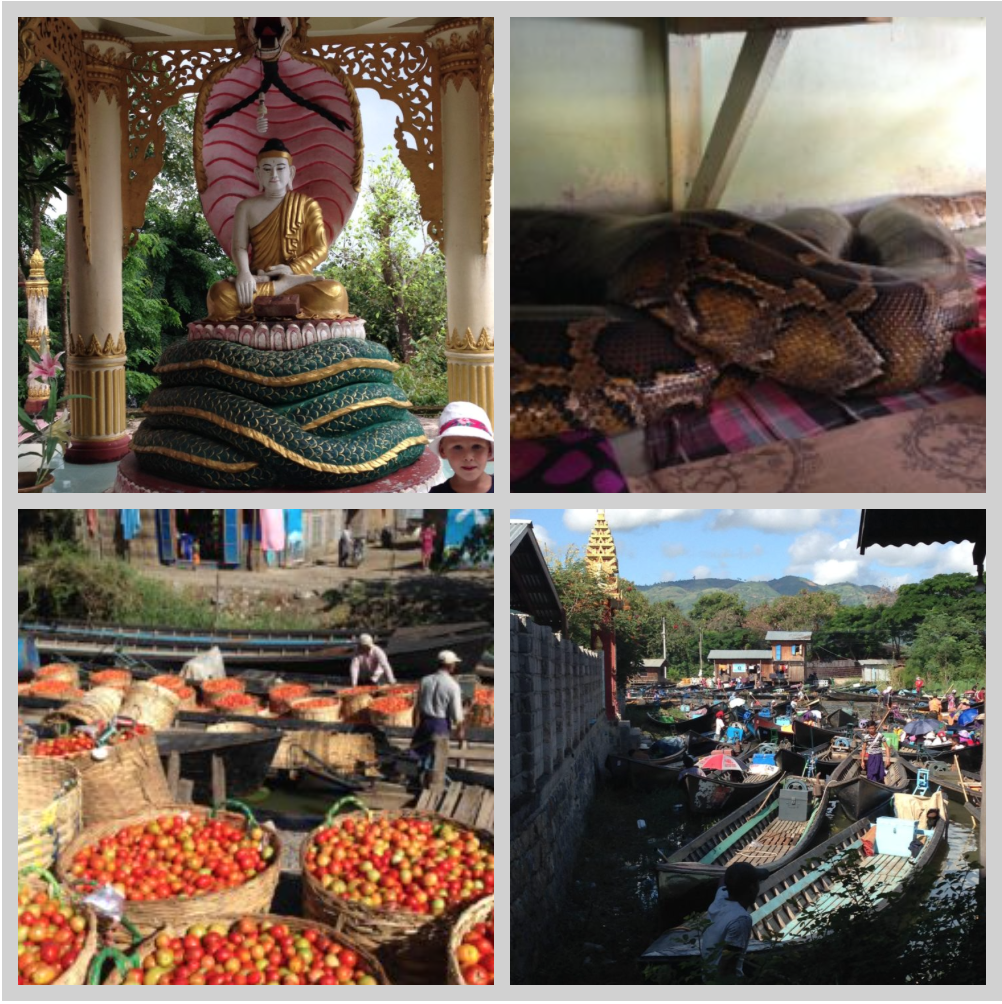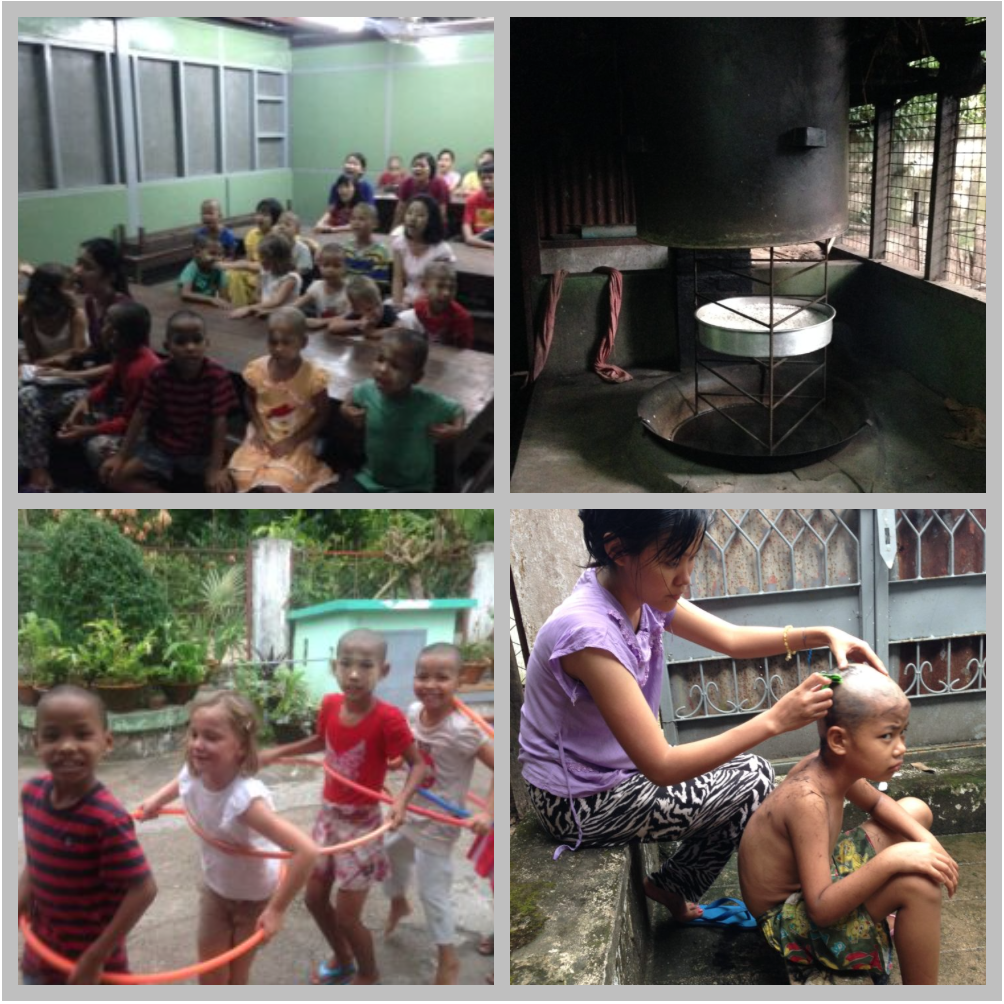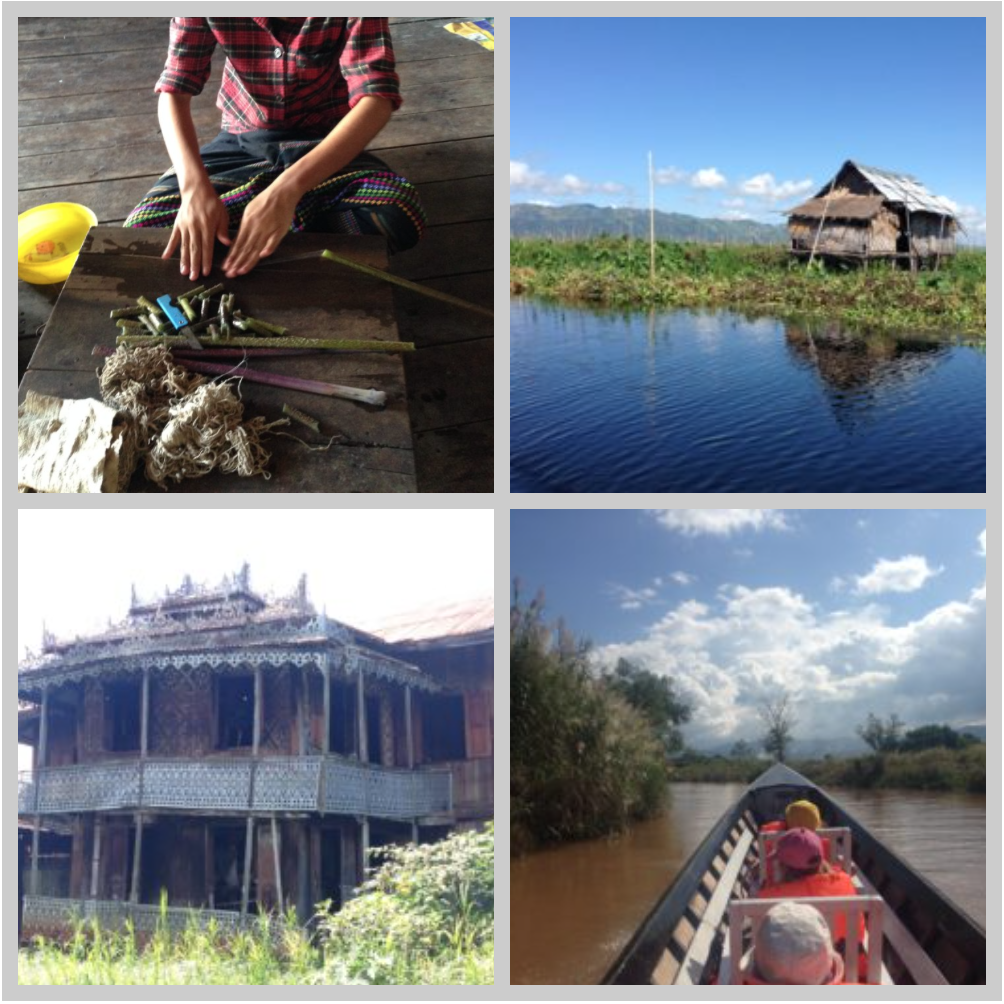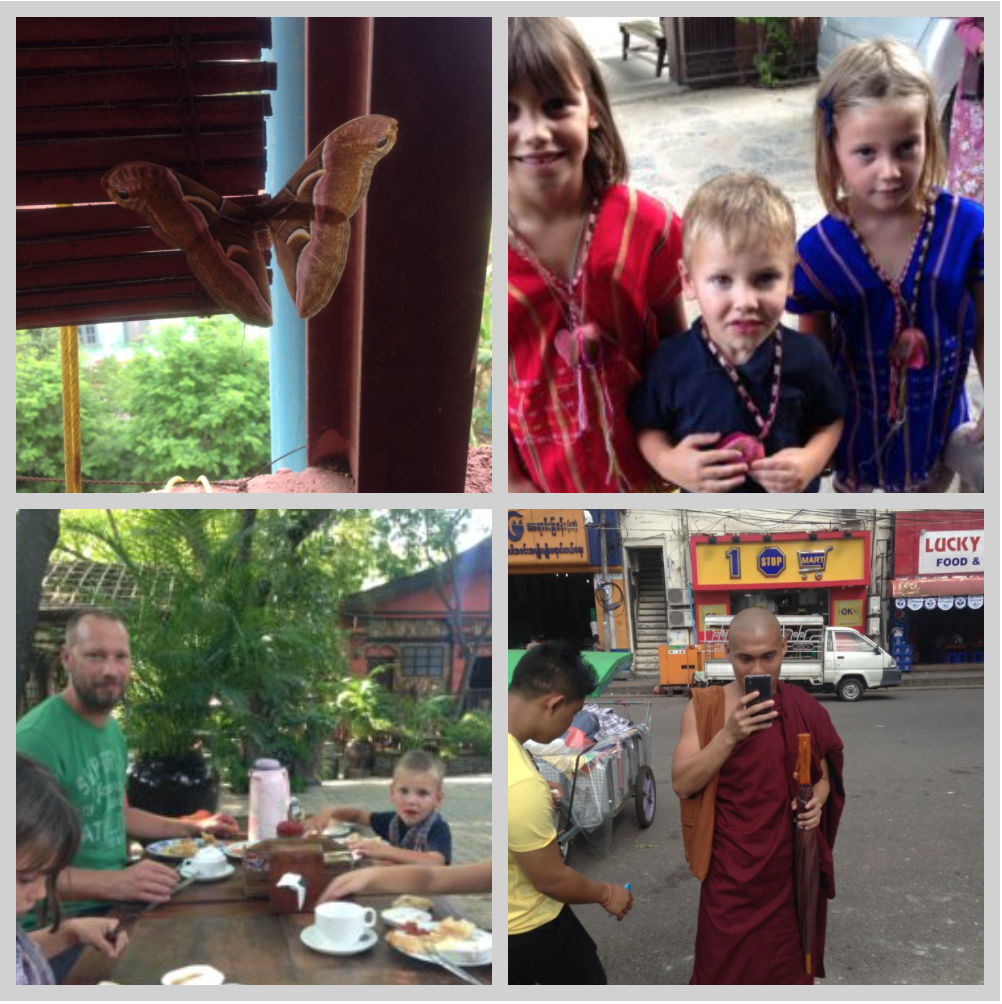urmese vocabulary: 6 words Tummy bugs: 1 Fevers: 3 Power cuts: 4 Personal items misplaced: 5 Favourite Burmese dishes: fried watercress & eggplant curry Treats: Dermalogica facial & Burmese reflexology (so painful) Thing I am most missing: my pillow
3 SMALL KIDS, 2 CRAZY ADULTS, 1 YEAR TO TRAVEL THE WORLD
POST 5: 10th October 2016, Lake Inle, Myanmar.
Temples, pagodas and stupas - do you know the difference? I didn't, but I sure do now! Because this is what Myanamar does. On a GRAND scale. So if you are being diligent little tourists (as we have been) it is quite easy to get temple fatigue. Almost everywhere you look there is one of them: either golden, stone or made of bricks, adorned or plain, small or immense, shiny and pristine or slowly being reclaimed by vegetation.
This is is because religion is a part of life in Burma and every boy spends at least one month as a novice in a monastery and most spend up to a year there. These provide children with an education, and also allow the religious leaders to keep an eye out for the next (fifth) incarnation of Buddha, who is expected soon. Moreover, monasteries provide the country with a degree of political stability because there are too many of them for the government to ignore. In return, the Burmese donate from between 10 to 30% of their annual income to the monks and nuns, who rely entirely upon this.
As well as being the second most philanthropic race in the world, the Burmese have to be my all-time favourite SE Asian people. They are so smiley, warm, honest and kind. They made our arrival at our homestay in Yangon a highlight because to say that they like children would be a major understatement. They virtually abducted ours every time we got home from sight-seeing!
We saw the same display of affection from the gorgeous orphans we visited in Bago. A total of 36 live at Grace Home for the Needy, many as a result of the cyclone that devastated much of the southern part of the country in 1996. Others are here because the region they were born in is too remote to offer any form of education to its population, and some were ‘rescued’ from rubbish dumps or left parent-less through abandonment, childbirth or social circumstances. Despite these tragic starts in life, they all seemed remarkably self-assured and happy: they played together as a family would - the elder members keeping a watchful eye on the youngest and there was lots of teasing and laughing.
Photo caption: Bago snake temple (top left) with its 6 metre, 128 year old python which is said to be the reincarnation of a famous monk (top right); one can receive family blessings of health and abundance by donating money to the snake keeper who says a prayer based on the day of the week you were born (the Burmese follow this special astrology very carefully). Xanthe summed it up nicely by saying "so you give the snake money and he gives you money back?" Yes. Exactly. Hopefully more than you gave him! Busy water thoroughfares coming in from Lake Inle to its surrounding villages (bottom)
What was really impressive was the responsibility with which each child undertook their specific duties. These were age-dependent and ranged from twice-daily sweeping of the entire compound, wiping clean the dining room tables, washing up the dishes, hand-washing of all the laundry and cooking the mountains of rice they get through each day. Shaving each other’s hair with a razor blade was a task reserved for the older children, and whilst not something any child relished, it was compulsory for all to keep lice at bay (until the age of 13 when they are considered old enough to look after themselves).
Photo caption: the orphans sitting down to sing their prayers before supper (top left); cooking rice over an open fire (top right); play time (bottom left); hair shave time for 7 year old Jennie (bottom right)
We are now in Inle Lake, a 20km-long but only 5m deep expanse of water surrounded by distant, forest-covered mountains. At 900 metres above sea level, it is Myanmar's first UNESCO biosphere reserve and is home to the Intha tribe. (The government recognise 135 distinct groups in total, which are placed under eight categories of 'major national ethnic races'. There are still ethnic tensions in this country and constant skirmishes along the border with Thailand mean that this area, along with other 'sensitive' hot spots are not open to tourists).
The Intha fishing folk are renowned for the way in which they row using just one foot, the other used to balance on their long punt-like boats, whilst using their two free hands to manoeuvre their fishing line or net. Luckily our visit coincided with the Phaung-Daw U festivities, during which 5 golden Buddhas are transported from one lakeside village to another. This seems to have attracted a larger cross-section of ethnic groups than we have seen before, which are recognisable, amongst other things by the different ways in which they wear and tie their head scarves.
Photo caption: different ethnic head-dress styles, for example: tied at the front with two triangular ‘ears’ on each side; tied at the front with the flaps resting on the head or tied at the back.
In some, the Buddhas reside overnight, in others, less than a day. In Nyaungshwe, where we are staying, the symbolic golden stones remained for a total of three nights. They arrived on a float which was slowly hauled past us by hundreds of locals jostling to hold the rope, whilst spectators lined the streets laden with offerings such as sweets, fruits and drinks. Behind the float snaked an endless procession of aubergine-clad monks followed by hoards of schoolchildren chanting and praying.
Photo caption: jostling to touch the rope (top left); monks following on behind (top right); the majestic, golden barge (bottom left); young men rowing with their feet (bottom right)
Their exit by water was even more impressive as the huge, golden barge taking the form of the Karaweik (the mythological Burmese bird with its large beak and carved feathers) was dragged along by the foot-power of thousands of young men. Each used one foot to row to the steady rhythm of cymbals and drums and one to steady themselves on their long, dug-out canoes. With 80 or so men on each side of every boat and hundreds of these joined together by a thick rope, it was a very impressive site as they glided by, majestically bound for their new temporary home.
Lake Inle is famed for its natural beauty, agreeable climate (its cooler, less humid days were a hit with the colonial British) and for the bamboo-plaited houses that perch on stilts around its periphery. Many of its villages specialise in particular skills: cigar-rolling, silk and lotus root-weaving, paper umbrella-making or silver work, and we visited these in a traditional, dug-out canoe. Despite feeling a little forced into buying something afterwards, I am very chuffed with my Inthe-style, woven scarf which, as any self-respecting fashionista will already know, featured heavily in one of Isabel Marant’s latest collections (you heard it here first).
Photo caption: the laborious process of extracting the lotus thread from the plant - see the lotus plant, the thread above and a piece of woven material above that (top left); a floating garden with its shed (top right); an elaborately-carved lake house on stilts (bottom left); cruising up the backwaters (bottom right)
Another draw to Inle, is its aquatic allotments. These seem to sprout directly out of the water but are actually rooted in a thick mat of grasses, reeds and algae which occur naturally in the many small rivers which lead onto the lake. Farmers cut and drag them into it, adding soil to create a floating garden.
Whilst it has been nice to spend some time on the water as opposed to just gazing at it (one of the attractions of Yangon is its many lakes), there is still something I don’t like about this area. Perhaps it is because it feels so much like a tourist hot-spot with its massages, milkshakes, wine, pancakes and pizzas. On the upside, this has meant that the kids have been able to eat more than just rice, eggs, chips, fruit juice and bananas, but on the downside, there is something very inauthentic about the feel of the place.
Photo caption: insects are on the large side here (top left); the kids with their lotus flower garlands after the Lake Inle procession (top right); alfresco breakfast (bottom left); causing a stir (bottom right)
Perhaps we are just missing our former super-star status. Because in Yangon and Bago, we were very much in the minority and the kids in particular were constantly having their heads patted, chins stroked, cheeks squeezed or arms pulled by the locals, as though touching them would bring good luck. A photo with one or both of them was a particular draw and they even stopped monks in their tracks. This seems ironic given that the guidebook says that both touching someone’s head as well as taking photos without permission is considered rude. Obviously not when it is the locals doing it!
To see where we are on a map, click here!
Did you enjoy this post? Let me know in the comments or by sharing it with other social media! Don’t forget to use the sign up form to receive my latest posts via e-mail. You can also follow me on facebook, youtube, twitter, instagram & pinterest!








